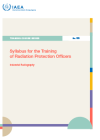The section’s primary programmatic roles are to develop IAEA Safety Standards and guidelines on radiation safety for the public, workers, patients and the environment, and to assist countries in implementing the standards. Radiation safety monitoring services are also provided to IAEA staff, experts, trainees and visitors to protect them from the harmful effects of ionizing radiation.
Radiation Safety and Monitoring Section
Protection of workers
The section supports countries in assessing, optimizing and evaluating the effectiveness of their national arrangements for occupational radiation protection, including through its Occupational Radiation Protection Appraisal Service (ORPAS). It also manages the Occupational Radiation Protection Networks (ORPNET) platform, which aims to harmonize occupational radiation protection worldwide, and administers the Information System on Occupational Exposure in Medicine, Industry and Research (ISEMIR) for the collection and analysis of occupational exposure data that is used to strengthen radiation protection of workers.
Protection of patients
Medical exposure is the largest human made source of ionizing radiation, used to diagnose and treat patients in the form of X rays, PET and CT scans, and by radiotherapy and nuclear medicine. The Radiation Protection of Patients (RPOP) website, with FAQs, webinars and training material, supports the implementation of current safety standards in healthcare, as do the voluntary reporting and learning systems in medical uses of radiation: SAFety in RADiological procedures (SAFRAD) and SAFety in Radiation ONcology (SAFRON).
Protection of the public and the environment
Radioactivity is naturally part of our Earth, made up of cosmic radiation and the radiation arising from the decay of various radionuclides in the Earth’s crust (soil, rocks, minerals, ores). When a decision is taken to control exposure to such radioactivity, these exposures are categorized as ‘existing exposure situations’. As this includes radionuclides from past activities or accidents, the section cooperates with the Waste and Environmental Safety Section in preparing safety standards. It also develops safety standards in areas such as consumer products, food safety and non-medical imaging.
Protection of staff: IAEA laboratories
The accredited Radiation Safety Technical Services Laboratory, which has locations in Vienna and Seibersdorf, Austria, provides radiation monitoring and protection services specifically for IAEA staff and other experts who carry out activities under IAEA assistance or supervision. The laboratory also loans radiation survey equipment, provides radiation safety training for the staff and experts, and aspires to act as a model for how similar laboratories can ensure radiation safety for staff.
Assistance following the 2011 Fukushima Daiichi nuclear accident
Since 2012, the section has cooperated with Fukushima Prefecture following the 2011 TEPCO Fukushima Daiichi Nuclear Power Plant accident, providing assistance with radiation monitoring, waste management and remediation for safety related aspects. This assistance is provided in cooperation with the Waste and Environmental Safety Section. Since 2023, efforts have focused on a lecture programme to transfer relevant knowledge to students and researchers in the prefecture.
Partnerships
The section coordinates the scientific secretariat for the IAEA Radiation Safety Standards Committee (RASSC) and represents the IAEA as a member of the Inter-Agency Committee on Radiation Safety, to further promote an internationally harmonized approach to radiation protection. It has established a number of cooperative agreements (Practical Arrangements) with institutions and authorities in several countries, as well as with international organizations, to enhance radiation protection globally.
Read more about the section’s work on radiation protection of workers, the public, patients and the environment.








